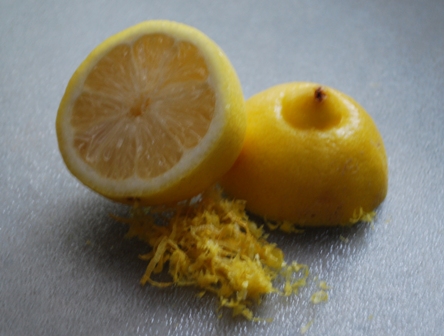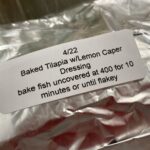 Last week a client asked me what lemon zest was. He was his families Chief Chef and like most family cooks, shied away from recipes that included procedures or ingredients he wasn’t familiar with or found intimidating. He didn’t know what lemon zest was or that it was something he could do, so he just skipped it. With his need for knowledge in mind, this post is dedicated to lemon zest… what it is, why you’d use it, what other fruits can be “zested” and how to do it step by step. Here’s goes…
Last week a client asked me what lemon zest was. He was his families Chief Chef and like most family cooks, shied away from recipes that included procedures or ingredients he wasn’t familiar with or found intimidating. He didn’t know what lemon zest was or that it was something he could do, so he just skipped it. With his need for knowledge in mind, this post is dedicated to lemon zest… what it is, why you’d use it, what other fruits can be “zested” and how to do it step by step. Here’s goes…
What is Lemon Zest?
Lemon zest is outermost, bright yellow layer of the skin of a lemon. It contains the lemons flavorful oil, and when removed from the lemon properly, meaning with little if any pale yellow lemon flesh, is not in any way bitter or sour.
When Do I Use Lemon Zest?
Of course when a recipe calls for it, but the purpose is to give the dish a pure, fresh, clean lemon taste. It is often used in baking, sauces, salad dressings and really anything that needs a little fresh lemon zing.
Is Lemon the Only Fruit I Can Zest?
No. All citrus fruits can be zested. If your recipe calls for the zest of a lime, orange or grapefruit, go forth and zest with abandon! Each fruit imparts its own unique flavor, so unless you understand the impact of zest flavor of each fruit, stick with the recipe and use what’s called for.
OK… So How Do I Zest a Lemon?
Zesting is actually one of the simpler how to’s. Follow the instructions below and you’ll be a zesting maven in no time!
Start with clean scrubbed lemons. You’ll only be using the outermost layer and that’s the part that gets dirty, so clean it first. If you’ll be using the juice of the lemon as well, it’s a good idea to roll the lemon on the counter to release its juices before zesting. You won’t be juicing the lemon until after you’ve zested it, but the outer layer of the lemon you will be removing helps keep the juice intact when you roll the lemon on the counter.
Next you zest! You’ll need a tool to do this. Cutting the zest off with a knife is too aggressive and unless you’re highly skilled, which I’m not, you’ll take off more than the thin outer layer resulting in a bitter flavor.
Common zesting tools include a zester which will remove long strips of zest from your lemon. I’ve used an OXO Good Grips Zester effectively for years and can recommend it without question. You’ll hold the lemon between your forefinger and your thumb with one hand and drag the holes of the zester along the skin of the lemon to remove the zest. The strips of zest will be quite long, so you’ll want to chop them up a bit before using.
The chef’s on TV generally use a microplane. You can get a plain Jane get the job done microplane at the hardware store or you can buy a fancy version made specifically for zesting and grating at places like Bed Bath & Beyond. In my opinion, the only advantage to a fancy microplane is that it generally will have a handle. You may also be able to find one with large or small holes if you prefer one over the other.
 To zest with a microplane, you’ll once again hold onto your lemon in one hand and drag the sharp edges of the microplane over the lemon to remove the zest. Some of the zest will drop from the microplane onto your work surface, but the majority will catch on the underside of the tool, so you’ll need to wipe it off. The advantage of a microplane over a zester is that the zest itself will be quite small and generally won’t require additional chopping. And, because the microplane has more holes, you’ll be able to zest an entire lemon in a less time.
To zest with a microplane, you’ll once again hold onto your lemon in one hand and drag the sharp edges of the microplane over the lemon to remove the zest. Some of the zest will drop from the microplane onto your work surface, but the majority will catch on the underside of the tool, so you’ll need to wipe it off. The advantage of a microplane over a zester is that the zest itself will be quite small and generally won’t require additional chopping. And, because the microplane has more holes, you’ll be able to zest an entire lemon in a less time.
No zestor or microplane? Try a vegetable peeler. The peeler will allow you to shave off the zest layer, but the zest will need to be chopped for proper use.
Now that you’re a zesting pro, you can try the following American Heart Association recipe for Berry Explosion Salad. And, if you’ve got a recipe that includes lemon zest send it my way. I just might post it!
Berry Explosion Salad
Ingredients
- 2 cups sliced fresh berries, such as strawberries, blueberries, raspberries, or blackberries
- 1/2 medium mango, cubed
- 4 fresh mint leaves
- 1 tablespoon light brown sugar
- 1/2 medium green kiwifruit, peeled and cut crosswise
- 1/2 cup fat-free or light vanilla yogurt
- 1/2 teaspoon grated lemon zest
- 1/8 cup sliced almonds, dry-roasted
Cooking Instructions
- Put the berries and mango in a large bowl.
- Using a mortar and pestle, combine the mint and brown sugar until the mint is bruised and the flavor is released. Add to the berry mixture. Using two spoons, toss gently to coat.
- Put the kiwifruit in a small bowl. Mash with a fork. Stir in the yogurt and lemon zest.
- To serve, sprinkle the almonds on top of the salad. Spoon the vanilla-yogurt dressing on top or serve on the side.





